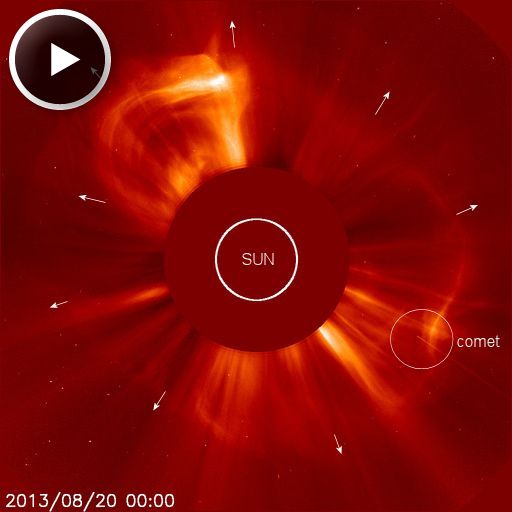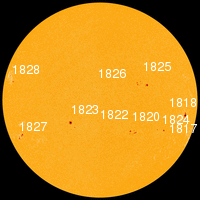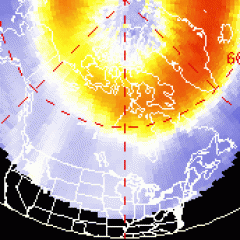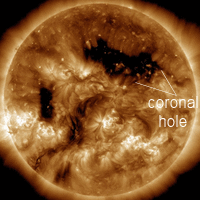OFF-TARGET CME COULD SPARK STORMS: According to NOAA analysts, a CME hurled into space by an M3-class solar flare on August 17th will probably miss Earth. However, Earth will likely pass through the wake of the CME after the cloud itself passes by. This could trigger polar geomagnetic storms despite the CME being off-target. High-latitude sky watchers should be alert for auroras on August 20-21. Aurora alerts: text, voice.
SUNDIVING COMET AND FULL-HALO CME: A small comet plunged into the sun this morning, and just before it arrived, the sun expelled a magnificent full-halo CME. Click to view a movie from the Solar and Heliospheric Observatory (SOHO):
In the final frames of the movie, the comet can be seen furiously vaporizing. Indeed, those were the comet's final frames. It did not emerge again from its flyby of the hot sun. "With a diameter of perhaps a few tens of meters, this comet was clearly far too small to survive the intense bombardment of solar radiation," comments Karl Battams of the Naval Research Lab, who studies sungrazing comets.
The CME (coronal mass ejection) came from an explosion on the farside of the sun. Although the CME and the comet appear to intersect, there was probably no interaction between the two. The comet is in the foreground and the farside CME is behind it.
Occasionally, readers ask if sundiving comets can trigger solar explosions. There's no known mechanism for comets to spark solar flares. Comets are thought to be too small and fragile to destabilize the sun's magnetic fields. Plus, this comet was still millions of kilometers from the sun when the explosion got underway.
The comet, R.I.P., was a member of the Kreutz family. Kreutz sungrazers are fragments from the breakup of a single giant comet many centuries ago. They get their name from 19th century German astronomer Heinrich Kreutz, who studied them in detail. Several Kreutz fragments pass by the sun and disintegrate every day. Most, measuring less than a few meters across, are too small to see, but occasionally a bigger fragment like this one attracts attention.

Solar wind
speed: 371.2 km/sec
density: 2.6 protons/cm3
explanation | more data
Updated: Today at 1537 UT
X-ray Solar Flares
6-hr max: C1 1000 UT Aug20
24-hr: C1 0129 UT Aug20
explanation | more data
Updated: Today at: 1500 UT
![]()
Daily Sun: 20 Aug 13
Sunspot AR1825 has a 'beta-gamma' magnetic field that poses a threat for M-class solar flares. Credit: SDO/HMI
![]()
Sunspot number: 161
What is the sunspot number?
Updated 20 Aug 2013
Spotless Days
Current Stretch: 0 days
2013 total: 0 days (0%)
2012 total: 0 days (0%)
2011 total: 2 days (<1%)
2010 total: 51 days (14%)
2009 total: 260 days (71%)
Since 2004: 821 days
Typical Solar Min: 486 days
Update 20 Aug 2013
The Radio Sun
10.7 cm flux: 128 sfu
explanation | more data
Updated 20 Aug 2013
![]()
Current Auroral Oval:
Switch to: Europe, USA, New Zealand, Antarctica
Credit: NOAA/POES
![]()
Planetary K-index
Now: Kp= 1 quiet
24-hr max: Kp= 1 quiet
explanation | more data
Interplanetary Mag. Field
Btotal: 2.6 nT
Bz: 0.4 nT north
explanation | more data
Updated: Today at 1537 UT
![]()
Coronal Holes: 18 Aug 13
Earth is inside a stream of solar wind flowing from this coronal hole. Credit: SDO/AIA.





